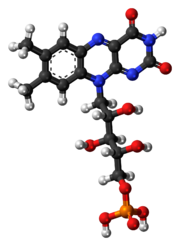
Back أحادي نوكليوتيد الفلافين Arabic فلاوین مونونوکلئوتید AZB Riboflavin-5'-fosfat BS Mononucleòtid de flavina Catalan Flavinmononukleotid Czech Flavinmononukleotid German Flavín mononucleótido Spanish فلاوین مونونوکلئوتید Persian Flaviinimononukleotidi Finnish Flavine mononucléotide French

| |

| |
| Names | |
|---|---|
| IUPAC name
1-Deoxy-1-(7,8-dimethyl-2,4-dioxo-3,4-dihydrobenzo[g]pteridin-10(2H)-yl)-D-ribitol 5-(dihydrogen phosphate)
| |
| Systematic IUPAC name
(2R,3S,4S)-5-(7,8-Dimethyl-2,4-dioxo-3,4-dihydrobenzo[g]pteridin-10(2H)-yl)-2,3,4-trihydroxypentyl dihydrogen phosphate | |
Other names
| |
| Identifiers | |
3D model (JSmol)
|
|
| ChEBI | |
| ChEMBL | |
| ChemSpider | |
| ECHA InfoCard | 100.005.150 |
| E number | E101a (colours) |
| MeSH | Flavin+mononucleotide |
PubChem CID
|
|
| UNII | |
CompTox Dashboard (EPA)
|
|
| |
| |
| Properties | |
| C17H21N4O9P | |
| Molar mass | 456.344 g/mol |
| Melting point | 195 °C |
Except where otherwise noted, data are given for materials in their standard state (at 25 °C [77 °F], 100 kPa).
| |
This article needs additional citations for verification. (December 2009) |
Flavin mononucleotide (FMN), or riboflavin-5′-phosphate, is a biomolecule produced from riboflavin (vitamin B2) by the enzyme riboflavin kinase and functions as the prosthetic group of various oxidoreductases, including NADH dehydrogenase, as well as a cofactor in biological blue-light photo receptors.[1] During the catalytic cycle, a reversible interconversion of the oxidized (FMN), semiquinone (FMNH•), and reduced (FMNH2) forms occurs in the various oxidoreductases. FMN is a stronger oxidizing agent than NAD and is particularly useful because it can take part in both one- and two-electron transfers. In its role as blue-light photo receptor, (oxidized) FMN stands out from the 'conventional' photo receptors as the signaling state and not an E/Z isomerization.
It is the principal form in which riboflavin is found in cells and tissues. It requires more energy to produce, but is more soluble than riboflavin. In cells, FMN occurs freely circulating but also in several covalently bound forms.[2] Covalently or non-covalently bound FMN is a cofactor of many enzymes playing an important pathophysiological role in cellular metabolism. For example dissociation of flavin mononucleotide from mitochondrial complex I has been shown to occur during ischemia/reperfusion brain injury during stroke.[3][4]
- ^ Tsibris, John C. M.; McCormick, Donald B.; Wright, Lemuel D. (1966). "Studies on the Binding and Function of Flavin Phosphates with Flavin Mononucleotide-dependent Enzymes". Journal of Biological Chemistry. 241 (5): 1138–43. doi:10.1016/S0021-9258(18)96813-4. PMID 4379862.
- ^ Mewies M, McIntire WS, Scrutton NS (1998). "Covalent attachment of flavin adenine dinucleotide (FAD) and flavin mononucleotide (FMN) to enzymes: The current state of affairs". Protein Science. 7 (1): 7–20. doi:10.1002/pro.5560070102. PMC 2143808. PMID 9514256.
- ^ Kahl, A; Stepanova, A; Konrad, C; Anderson, C; Manfredi, G; Zhou, P; Iadecola, C; Galkin, A (2018). "Critical Role of Flavin and Glutathione in Complex I-Mediated Bioenergetic Failure in Brain Ischemia/Reperfusion Injury". Stroke. 49 (5): 1223–1231. doi:10.1161/STROKEAHA.117.019687. PMC 5916474. PMID 29643256.
- ^ Galkin, A (2019). "Brain Ischemia/Reperfusion Injury and Mitochondrial Complex I Damage". Biochemistry. Biokhimiia. 84 (11): 1411–1423. doi:10.1134/S0006297919110154. PMID 31760927. S2CID 207990089.